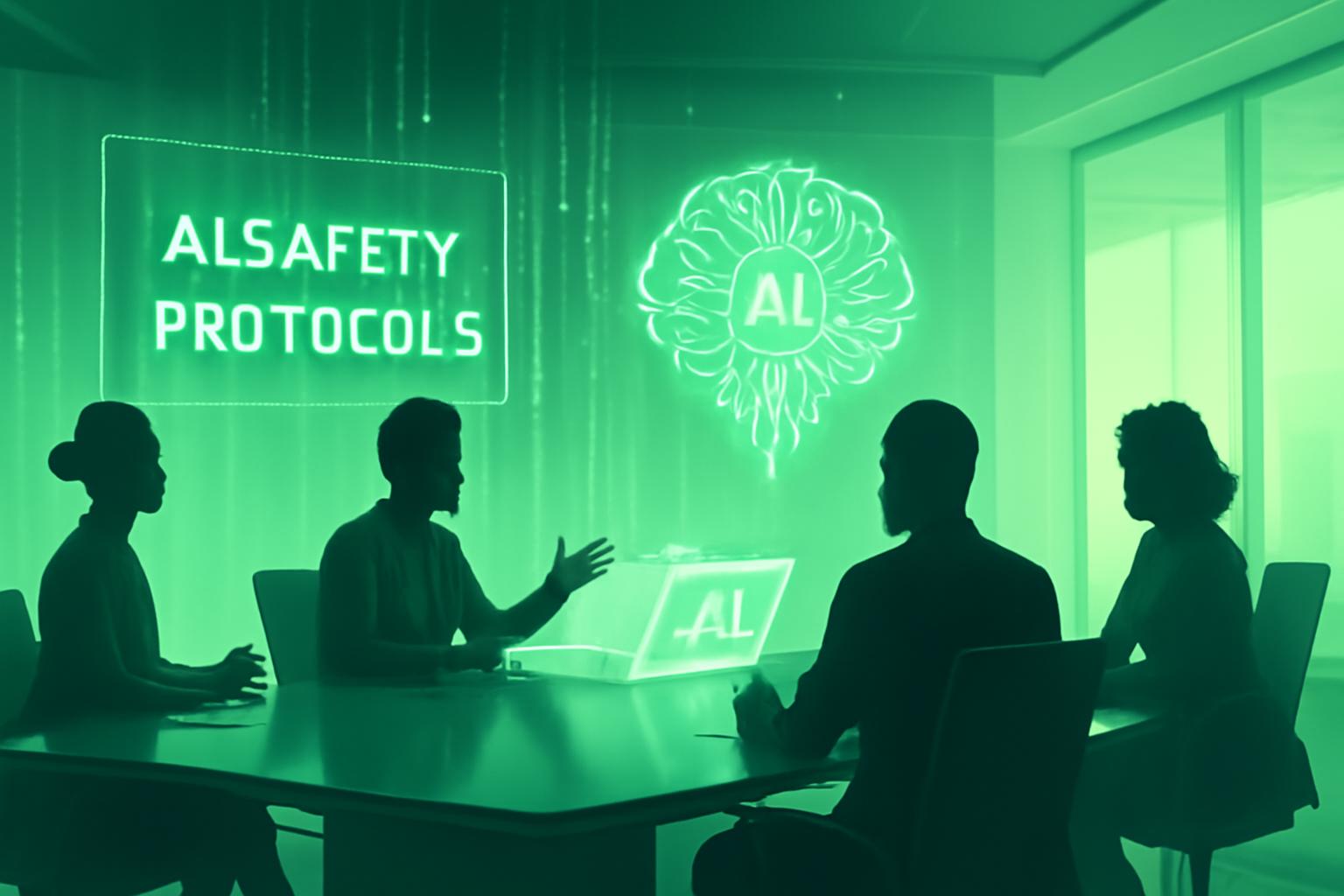FinOracleAI — Market View
California’s SB 53 sets a precedent for state-driven AI regulation, signaling an increasing willingness among policymakers to impose transparency and accountability measures on powerful AI developers. This law could catalyze a wave of similar legislation, potentially creating a fragmented regulatory landscape but also enhancing public trust in AI technologies.
- Opportunities: Improved AI safety standards may reduce risks of harm and increase consumer confidence, encouraging broader adoption.
- Risks: Divergent state regulations could complicate compliance for AI companies, potentially slowing innovation and increasing operational costs.
- Whistleblower protections may empower employees to expose unsafe AI practices, fostering industry accountability.
- Establishment of incident reporting mechanisms could lead to better monitoring and mitigation of AI-related threats.
Impact: SB 53 is a significant regulatory milestone that balances innovation with safety. While it introduces compliance challenges, it also positions California as a leader in shaping responsible AI governance.
Governor Newsom is also reviewing Senate Bill 243 (SB 243), which has bipartisan support and would regulate AI companion chatbots. This bill would require operators to implement safety protocols and hold them legally accountable for failures to meet these standards.
SB 53 represents Senator Scott Wiener’s second attempt at AI safety legislation after his broader SB 1047 was vetoed last year due to industry pushback. This iteration involved consultations with AI companies to address prior concerns.
FinOracleAI — Market View
California’s SB 53 sets a precedent for state-driven AI regulation, signaling an increasing willingness among policymakers to impose transparency and accountability measures on powerful AI developers. This law could catalyze a wave of similar legislation, potentially creating a fragmented regulatory landscape but also enhancing public trust in AI technologies.
- Opportunities: Improved AI safety standards may reduce risks of harm and increase consumer confidence, encouraging broader adoption.
- Risks: Divergent state regulations could complicate compliance for AI companies, potentially slowing innovation and increasing operational costs.
- Whistleblower protections may empower employees to expose unsafe AI practices, fostering industry accountability.
- Establishment of incident reporting mechanisms could lead to better monitoring and mitigation of AI-related threats.
Impact: SB 53 is a significant regulatory milestone that balances innovation with safety. While it introduces compliance challenges, it also positions California as a leader in shaping responsible AI governance.
Governor Newsom is also reviewing Senate Bill 243 (SB 243), which has bipartisan support and would regulate AI companion chatbots. This bill would require operators to implement safety protocols and hold them legally accountable for failures to meet these standards.
SB 53 represents Senator Scott Wiener’s second attempt at AI safety legislation after his broader SB 1047 was vetoed last year due to industry pushback. This iteration involved consultations with AI companies to address prior concerns.
FinOracleAI — Market View
California’s SB 53 sets a precedent for state-driven AI regulation, signaling an increasing willingness among policymakers to impose transparency and accountability measures on powerful AI developers. This law could catalyze a wave of similar legislation, potentially creating a fragmented regulatory landscape but also enhancing public trust in AI technologies.
- Opportunities: Improved AI safety standards may reduce risks of harm and increase consumer confidence, encouraging broader adoption.
- Risks: Divergent state regulations could complicate compliance for AI companies, potentially slowing innovation and increasing operational costs.
- Whistleblower protections may empower employees to expose unsafe AI practices, fostering industry accountability.
- Establishment of incident reporting mechanisms could lead to better monitoring and mitigation of AI-related threats.
Impact: SB 53 is a significant regulatory milestone that balances innovation with safety. While it introduces compliance challenges, it also positions California as a leader in shaping responsible AI governance.
In parallel, Silicon Valley leaders have invested heavily in political action committees (super PACs) advocating for lighter AI regulation. OpenAI and Meta have launched pro-AI super PACs to support candidates and legislation favoring a less restrictive regulatory framework.
Despite opposition, California’s legislation is likely to serve as a model for other states. New York, for example, has passed a similar bill awaiting gubernatorial approval.
Governor Newsom’s Perspective
“California has proven that we can establish regulations to protect our communities while also ensuring that the growing AI industry continues to thrive,” Governor Newsom stated. “This legislation strikes that balance. AI is the new frontier in innovation, and California is not only here for it — but stands strong as a national leader by enacting the first-in-the-nation frontier AI safety legislation that builds public trust as this emerging technology rapidly evolves.”
Additional AI Regulation Under Consideration
Governor Newsom is also reviewing Senate Bill 243 (SB 243), which has bipartisan support and would regulate AI companion chatbots. This bill would require operators to implement safety protocols and hold them legally accountable for failures to meet these standards.
SB 53 represents Senator Scott Wiener’s second attempt at AI safety legislation after his broader SB 1047 was vetoed last year due to industry pushback. This iteration involved consultations with AI companies to address prior concerns.
FinOracleAI — Market View
California’s SB 53 sets a precedent for state-driven AI regulation, signaling an increasing willingness among policymakers to impose transparency and accountability measures on powerful AI developers. This law could catalyze a wave of similar legislation, potentially creating a fragmented regulatory landscape but also enhancing public trust in AI technologies.
- Opportunities: Improved AI safety standards may reduce risks of harm and increase consumer confidence, encouraging broader adoption.
- Risks: Divergent state regulations could complicate compliance for AI companies, potentially slowing innovation and increasing operational costs.
- Whistleblower protections may empower employees to expose unsafe AI practices, fostering industry accountability.
- Establishment of incident reporting mechanisms could lead to better monitoring and mitigation of AI-related threats.
Impact: SB 53 is a significant regulatory milestone that balances innovation with safety. While it introduces compliance challenges, it also positions California as a leader in shaping responsible AI governance.
In parallel, Silicon Valley leaders have invested heavily in political action committees (super PACs) advocating for lighter AI regulation. OpenAI and Meta have launched pro-AI super PACs to support candidates and legislation favoring a less restrictive regulatory framework.
Despite opposition, California’s legislation is likely to serve as a model for other states. New York, for example, has passed a similar bill awaiting gubernatorial approval.
Governor Newsom’s Perspective
“California has proven that we can establish regulations to protect our communities while also ensuring that the growing AI industry continues to thrive,” Governor Newsom stated. “This legislation strikes that balance. AI is the new frontier in innovation, and California is not only here for it — but stands strong as a national leader by enacting the first-in-the-nation frontier AI safety legislation that builds public trust as this emerging technology rapidly evolves.”
Additional AI Regulation Under Consideration
Governor Newsom is also reviewing Senate Bill 243 (SB 243), which has bipartisan support and would regulate AI companion chatbots. This bill would require operators to implement safety protocols and hold them legally accountable for failures to meet these standards.
SB 53 represents Senator Scott Wiener’s second attempt at AI safety legislation after his broader SB 1047 was vetoed last year due to industry pushback. This iteration involved consultations with AI companies to address prior concerns.
FinOracleAI — Market View
California’s SB 53 sets a precedent for state-driven AI regulation, signaling an increasing willingness among policymakers to impose transparency and accountability measures on powerful AI developers. This law could catalyze a wave of similar legislation, potentially creating a fragmented regulatory landscape but also enhancing public trust in AI technologies.
- Opportunities: Improved AI safety standards may reduce risks of harm and increase consumer confidence, encouraging broader adoption.
- Risks: Divergent state regulations could complicate compliance for AI companies, potentially slowing innovation and increasing operational costs.
- Whistleblower protections may empower employees to expose unsafe AI practices, fostering industry accountability.
- Establishment of incident reporting mechanisms could lead to better monitoring and mitigation of AI-related threats.
Impact: SB 53 is a significant regulatory milestone that balances innovation with safety. While it introduces compliance challenges, it also positions California as a leader in shaping responsible AI governance.
California Enacts Landmark AI Safety Legislation SB 53
California Governor Gavin Newsom has signed Senate Bill 53 (SB 53), marking the first state-level law in the United States to impose comprehensive transparency and safety requirements on large artificial intelligence (AI) companies. The legislation aims to increase accountability in the rapidly evolving AI sector by mandating disclosures of safety protocols and protecting employees who report concerns.
Key Provisions of SB 53
- Requires major AI labs—including OpenAI, Anthropic, Meta, and Google DeepMind—to publicly disclose their AI safety protocols.
- Establishes whistleblower protections for employees who raise safety concerns within AI companies.
- Creates a reporting mechanism for critical AI safety incidents to California’s Office of Emergency Services.
- Mandates reporting of AI-related criminal incidents, such as cyberattacks or deceptive behavior by AI models, even if not covered by existing EU AI regulations.
This legislation reflects California’s proactive approach to managing the risks associated with AI technologies while fostering innovation within the industry.
Industry Response and Political Context
The AI industry’s reaction to SB 53 has been mixed. While Anthropic publicly endorsed the bill, major companies such as Meta and OpenAI opposed it. OpenAI notably authored an open letter urging Governor Newsom not to sign the legislation, citing concerns over a fragmented regulatory environment that could impede innovation.
“State-level AI policy risks creating a patchwork of regulation that would hinder innovation,” argued representatives from several tech firms.
In parallel, Silicon Valley leaders have invested heavily in political action committees (super PACs) advocating for lighter AI regulation. OpenAI and Meta have launched pro-AI super PACs to support candidates and legislation favoring a less restrictive regulatory framework.
Despite opposition, California’s legislation is likely to serve as a model for other states. New York, for example, has passed a similar bill awaiting gubernatorial approval.
Governor Newsom’s Perspective
“California has proven that we can establish regulations to protect our communities while also ensuring that the growing AI industry continues to thrive,” Governor Newsom stated. “This legislation strikes that balance. AI is the new frontier in innovation, and California is not only here for it — but stands strong as a national leader by enacting the first-in-the-nation frontier AI safety legislation that builds public trust as this emerging technology rapidly evolves.”
Additional AI Regulation Under Consideration
Governor Newsom is also reviewing Senate Bill 243 (SB 243), which has bipartisan support and would regulate AI companion chatbots. This bill would require operators to implement safety protocols and hold them legally accountable for failures to meet these standards.
SB 53 represents Senator Scott Wiener’s second attempt at AI safety legislation after his broader SB 1047 was vetoed last year due to industry pushback. This iteration involved consultations with AI companies to address prior concerns.
FinOracleAI — Market View
California’s SB 53 sets a precedent for state-driven AI regulation, signaling an increasing willingness among policymakers to impose transparency and accountability measures on powerful AI developers. This law could catalyze a wave of similar legislation, potentially creating a fragmented regulatory landscape but also enhancing public trust in AI technologies.
- Opportunities: Improved AI safety standards may reduce risks of harm and increase consumer confidence, encouraging broader adoption.
- Risks: Divergent state regulations could complicate compliance for AI companies, potentially slowing innovation and increasing operational costs.
- Whistleblower protections may empower employees to expose unsafe AI practices, fostering industry accountability.
- Establishment of incident reporting mechanisms could lead to better monitoring and mitigation of AI-related threats.
Impact: SB 53 is a significant regulatory milestone that balances innovation with safety. While it introduces compliance challenges, it also positions California as a leader in shaping responsible AI governance.













